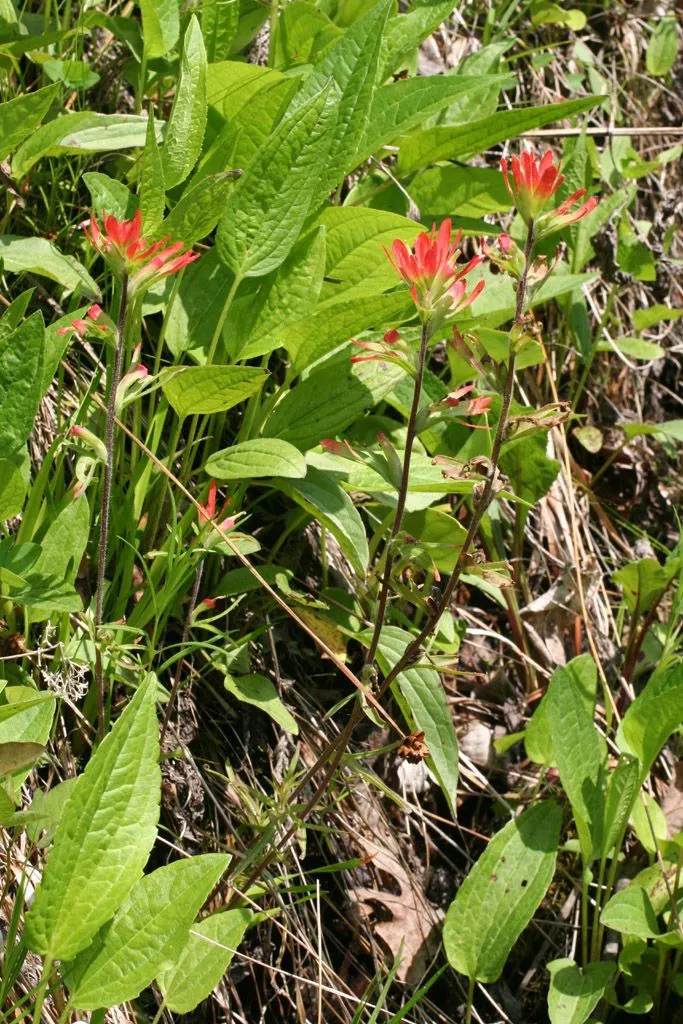
Author: (L.) Spreng.
Bibliography: Syst. Veg. 2: 775 (1825)
Year: 1825
Status: accepted
Rank: species
Genus: Castilleja
Vegetable: False
Observations: C. SE. Canada to C. & E. U.S.A.
The Scarlet Indian Paintbrush, known scientifically as Castilleja coccinea, is a captivating and vibrant wildflower that graces the landscapes of central and southeastern Canada, stretching down through central and eastern regions of the United States. Renowned for its striking appearance, this plant belongs to the Orobanchaceae family.
The Scarlet Indian Paintbrush takes its common name from the intense, paint-like coloration of its bracts, which can range from fiery reds to oranges. These bright hues create a stark contrast against the green foliage and often make the plant appear as though it has been dipped in scarlet paint. The actual flowers are diminutive and mostly concealed by the bracts, which serve as a visual attractant for pollinators such as hummingbirds and bees.
First formally described in the academic text “Syst. Veg.” (Systema Vegetabilium) in 1825 by botanist (L.) Spreng., Castilleja coccinea has fascinated botanists and nature enthusiasts alike for nearly two centuries. This perennial plant tends to thrive in habitats that offer full sun to partial shade and typically grows in prairies, meadows, and open woodlands. It favors well-drained soils and is often found in areas that have experienced disturbance, which provide ideal conditions for its seeds to germinate and grow.
The Scarlet Indian Paintbrush has a unique semi-parasitic nature, relying partially on the roots of neighboring plants for nutrients, a characteristic that sets it apart from many other flowering plants. This relationship does not usually harm the host plant but rather enhances the Painted Brush’s ability to thrive in various soil conditions.
In addition to its aesthetic appeal, the Scarlet Indian Paintbrush has been a subject of interest for its ecological role. It serves as an important food source for various pollinators and can contribute to the biodiversity and health of the ecosystems where it is found. Despite its beauty, the plant is sensitive to environmental changes and benefits from conservation efforts aimed at preserving native plant communities.
Whether encountered in a nature hike or a cultivated garden, Castilleja coccinea continues to captivate with its vibrant display and intriguing biological characteristics, standing as a striking symbol of the delicate intricacies of North American flora.
Eng: scarlet indian paintbrush, painted-cup paintbrush, scarlet paintbrush, scarlet painted-cup
Swe: scharlakansröd indianpensel
Fra: castilléjie écarlate
En: Scarlet Indian paintbrush, Scarlet Indian-Paintbrush, Painted-cup Paintbrush, Scarlet paintbrush, Scarlet painted-cup
Nl: Scarlet Indian paintbrush
Fr: Castilléjie écarlate
Sv: Scharlakansröd indianpensel
: Scarlet indian paintbrush
Taken Aug 5, 2020 by Grace Drake (cc-by-sa)
Taken Apr 23, 2021 by K O (cc-by-sa)
Taken Aug 28, 2022 by Katie Borek (cc-by-sa)
Taken May 30, 2021 by Nathan Barton (cc-by-sa)
Taken May 24, 2020 by kiki m (cc-by-sa)
Taken Apr 16, 2020 by caitlin (cc-by-sa)
Taken Apr 16, 2020 by caitlin (cc-by-sa)
Taken May 6, 2005 by EOL − Ron Thomas (cc-by-nc-sa)
Taken Apr 16, 2020 by caitlin (cc-by-sa)
Taken May 9, 2007 by EOL − Steven J. Baskauf (cc-by-nc-sa)
Taken May 9, 2007 by EOL − Steven J. Baskauf (cc-by-nc-sa)
Taken May 9, 2007 by EOL − Steven J. Baskauf (cc-by-nc-sa)
Taken May 9, 2007 by EOL − Steven J. Baskauf (cc-by-nc-sa)
Taken May 9, 2007 by EOL − Steven J. Baskauf (cc-by-nc-sa)
Taken May 9, 2007 by EOL − Steven J. Baskauf (cc-by-nc-sa)
Taken Dec 1, 2012 by EOL − Kenneth Bader (cc-by-nc)
Taken Jan 1, 1900 by EOL − Haug, E. (cc-by-nc-sa)
Taken Aug 30, 2013 by EOL − Kenneth Bader (cc-by-nc)
Growth form>: Single Crown
Growth habit>: Forb/herb
Growth rate>: Rapid
Ph maximum: 6.8
Ph minimum: 4.9
Family: Myrtaceae Author: (F.Muell.) K.D.Hill & L.A.S.Johnson Bibliography: Telopea 6: 402 (1995) Year: 1995 Status:…
Family: Rubiaceae Author: Pierre ex A.Froehner Bibliography: Notizbl. Bot. Gart. Berlin-Dahlem 1: 237 (1897) Year:…
Family: Sapindaceae Author: Koidz. Bibliography: J. Coll. Sci. Imp. Univ. Tokyo 32(1): 38 (1911) Year:…
Family: Asteraceae Author: A.Gray Bibliography: Pacif. Railr. Rep.: 107 (1857) Year: 1857 Status: accepted Rank:…
Family: Fabaceae Author: Medik. Bibliography: Vorles. Churpfälz. Phys.-Ökon. Ges. 2: 398 (1787) Year: 1787 Status:…
Family: Aspleniaceae Author: (Cav.) Alston Bibliography: Bull. Misc. Inform. Kew 1932: 309 (1932) Year: 1932…